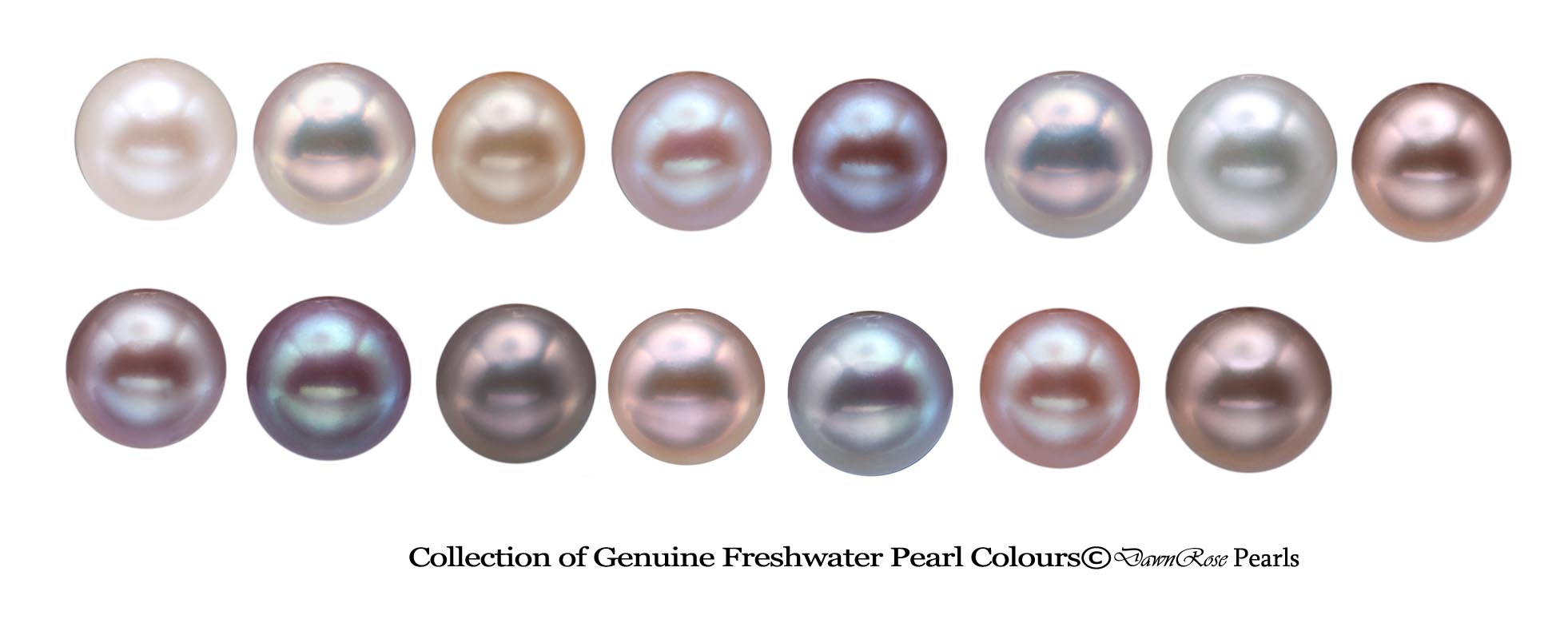An Overview of Pearl Grading Factors
Pearls are quality-graded and evaluated by: nacre, shape, size, surface quality, lustre, color and matching. A pearl must be graded by a combination of these factors rather than by any one individual factor. Some of the factors can be roughly judged by trained eyes, but in the grading system each factor must be precisely stated and classified into categories.
Pearl Nacre
Nacre is the material that a mollusk secretes to enclose an irritant introduced into its body and which creates the pearl. Nacre is the unique and vital substance of a “real” pearl. Due to bead nucleation techniques widely used in cultivating saltwater pearls in the current pearl production process, nacre is an important factor in determining just how much “real” pearl content a pearl contains. Thicker nacre means the bead nucleus is coated by more pearl content, and that the pearl will be more durable.
The thickness of nacre is typically measured in millimeters. Each grading system has a determined threshold of nacre thickness, below which a pearl is deemed unacceptable for sale, however this threshold of nacre thickness varies with each type of pearl. Freshwater pearls are almost 100% solid nacre because a bead nucleus is not used during the cultivation; therefore nacre is not a problem at all for Freshwater pearls and they will be durable for a lifetime. Most Tahitian and South Sea pearls have very thick nacre because of their large size and an official minimum nacre of 0.8mm must be present for lawful sale. Akoya pearls have a slightly thinner nacre due to their smaller sizes, but advanced cultivation techniques have made Akoya pearls very durable and lustrous, and their nacre thickness is strictly examined.
X-ray or other technical equipment must be used to officially determine nacre thickness, however, much can be determined by a trained eye.
If a pearl with thin nacre is held up to a light source and rotated, it will show strong blinking (appear light and then dark) with variations in its capacity to reflect light. The bead nucleus will often be slightly or clearly visible. A pearl with an acceptable nacre is one where you cannot see the nucleus, has an even and consistent shine and is not chalky.
Pearl Shape
 As pearls are entirely the creation of nature, their shapes can vary randomly: round, off-round, oval, resemble a drop or a button, have circular grooves or be entirely non-regular in shape (baroque). A perfectly spherical shape is the most rare and valuable and in general, the more round, the more valuable it will be. Typically only 1-5% of the pearl harvest is consistently round, but this does also depend on the pearl type and origin. Pearl shape is measured by the difference between the maximum and minimum diameter, and can be easily judged by the naked eye.
As pearls are entirely the creation of nature, their shapes can vary randomly: round, off-round, oval, resemble a drop or a button, have circular grooves or be entirely non-regular in shape (baroque). A perfectly spherical shape is the most rare and valuable and in general, the more round, the more valuable it will be. Typically only 1-5% of the pearl harvest is consistently round, but this does also depend on the pearl type and origin. Pearl shape is measured by the difference between the maximum and minimum diameter, and can be easily judged by the naked eye.
Pearl Surface

Any true pearl will have some blemishes or imperfectness on the surface. Should you find the surface perfectly smooth without any blemishes, it will be either an extremely valuable pearl (with matching price tag) or a fake. However, fake pearls can also be easily recognized by color, temperature, shape and other factors. It is, therefore, important to bear in mind that a real pearl will have some surface imperfection, and slight blemishes are quite acceptable even for the finest pearls.
Of course, a real pearl with less visible surface spotting will definitely be more valuable. A heavily blemished surface will not only diminish the overall beauty of a pearl, but may also seriously affect pearl durability, especially for bead nucleated pearls. This is because pearl nacre will be more likely to peel off of heavily blemished surfaces.
Pearl surface quality can generally be judged by eye or with the aid of a magnifying glass. The heaviest or most concentrated flaws are normally positioned near the drill hole, as a pearl jeweler will naturally choose the most blemished portion of the pearl to drill into. In the pearl grading system, the exact amount of flawed surface must be clearly stated and categorized.
Pearl Size

For round pearls the diameter of a pearl is measured to determine size in millimeters (mm). A pearl of irregular shape is determined by the difference between the maximum and minimum diameter.
Although it is generally true that the larger a pearl is, the greater its value, pearl type also plays a part in determining value, and it is actually how rare a pearl is that determines value. For example, South Sea or Tahitian pearls quite often grow over 10mm and even sometimes reach 18mm, however, because it is extremely rare to find freshwater or Akoya pearls of 10mm or more, such a pearl would command a higher price than a larger South Sea or Tahitian pearl. Thus pearl value does not depend on size alone.
Pearl Luster

Due to its layers of nacre, pearls reflect light in a unique way which is often described as luster. The higher the luster, the more reflective capacity a pearl will have. A pearl of high luster will have a mirror-like surface from which you can see sharp images, whereas a pearl of lower luster will look dull and not reflect clear images.
How lustrous a pearl is depends upon the consistency and number of its layers of nacre, as well as the translucence of the nacre. The intensity of luster is determined by the crystal structure of nacre called aragonite. In the past few decades, techniques have been honed to greatly improve the luster intensity of cultured pearls. Akoya pearls, once known as Japanese Akoya pearls, are considered to be the most lustrous pearls, however there are also various kinds of luster. For example, some people prefer the satiny luster of South Sea pearls rather than the sharp mirror-like luster of Akoya or Freshwater pearls. Another factor which figures into the equation is that of color overtones. It is luster combined with overtones which greatly enhances the beauty of a pearl and is the most important factor in evaluating pearls.
Pearl Colour
The natural color of a pearl is strongly associated with pearl origins, more specifically, the species of the mollusks. During the pearl grafting process, the implanted tissue from the donor mussel/oyster largely determines pearl color, however, living environments also influence pearl color.
Each type of pearl has its own categories of color. For example, only Tahitian oysters produce pearls with natural and highly unique dark metallic hues, while South Sea oysters produce richly hued white and golden pearls, and a classic white and creamy is typical for Akoya pearls. Freshwater pearls are more versatile, where colors of peach, white and lavender are commonly found.
Perhaps the most unique and enchanting thing about a pearl is that no one pearl is entirely uniform in color; it will always feature mixed colors. For example, a Tahitian pearl will never be pure black but will display colors ranging from dark green to dark yellow, and an Akoya pearl will never be pure white but will exhibit various hues of white, rose and creamy. In addition to its fundamental body color, a pearl will also show overtones. The overtone is an irradiance encompassing the entire pearl body and is a mixture of colors which varies according to the incident light a pearl reflects. Simply speaking, the colors irradiating from a true pearl will vary under different lights, whether that of the sun or a light bulb, and will also vary when viewing it from different angles.
Genuine Freshwater Pearl Colours

Genuine Tahitian Pearl Colours

Genuine South Sea Pearl Colours

Akoya Pearl Colours
Pearl Matching
Matching is the value factor applied to pairs or strands of pearls, such as in earrings, necklaces and bracelets. Matching refers to the uniformity of the pearls in luster, shape, surface, nacre thickness and size, which is significant in determining the overall appearance of multi-pearl jewelry. For a pearl strand, even a few flaws or low luster in several individual pearls will not affect the overall value if the pearls in the strand are matched with highly professional care. In most cases, the quality of the matching is a more important evaluating factor in a pearl strand than the quality of each individual pearl in it.
























